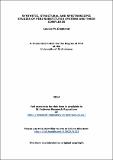Synthetic, structural and spectroscopic studies of peri-substituted systems and their complexes
Abstract
The family of polycyclic aromatic hydrocarbons naphthalene, acenaphthene and acenaphthylene, containing rigid organic backbones, allow the study of non-bonded intramolecular interactions. Due to the rigid framework, heteroatoms that are substituted at the peri-positions (positions 1- and 8- of the naphthalene ring and positions 5- and 6- of the acenaphthene and acenaphthylene rings) are forced to occupy space that is closer than the sum of their van der Waals radii, resulting in severe steric strain and unique interactions. In spite of this, a vast amount of peri-substituted naphthalenes have been prepared, however acenaphthene and acenaphthylene compounds have received much less attention.
Preparation of these sterically crowded systems is possible because of the backbones ability to relieve strain as a result of both attractive and repulsive interactions. Attractive interactions relax the backbone via formation of weak or strong bonds between the substituents. Alternatively, repulsive interactions can result in the deformation of the backbone away from its natural geometry by buckling the ring system and causing the peri-bonds to distort in-plane and out-of-plane. Peri-substituted systems can also ease strain by forming compounds with bridging atoms or through bidentate coordination to form metal complexes with, for example, metal bis(phosphine) or bis(thiolate) moieties.
The competition between attractive and repulsive forces, the method by which peri-substituted compounds relieve steric strain, is investigated in this thesis using a variety of different peri-moieties and the aforementioned organic backbones.
Chapter 2 initially focuses on the formation of a series of platinum bis(phosphine) complexes, constructed from corresponding peri-substituted naphthalenes, 1,8-naphthosultone and 1,8-naphthosultam, the chemistry of which is outlined in Chapter 1. A corresponding study of platinum bis(phosphine) complexes, constructed from analogous 5,6-dihydroacenaphtho[5,6-cd]-1,2-dithiole and 5,6-dihydroacenaphtho[5,6-cd]-1,2-diselenole bidentate ligands is provided in Chapter 6.
The chemistry of peri-substituted naphthalenes is well documented and a number of reviews have been written on this subject. Chapter 3, meanwhile, reviews the chemistry of related acenaphthene and acenaphthylenes which have seen increasing use in the literature over the last few years.
Chapter 4 investigates the relationship between repulsive and attractive interactions that occur between the peri-substituents in a series of bis-chalcogen, mixed chalcogen-chalcogen and mixed halogen-chalcogen acenaphthylenes. By comparison with their known naphthalene and acenaphthene counterparts, the effect the rigid aromatic ring system has on the molecular geometry is examined. Finally, Chapter 5 looks at a series of acenaphthene and acenaphthylene compounds containing ArTe peri-substituents and explores how repulsive and attractive interactions affect molecular conformation and Te•••Te spin-spin coupling constants.
Type
Thesis, PhD Doctor of Philosophy
Collections
Items in the St Andrews Research Repository are protected by copyright, with all rights reserved, unless otherwise indicated.

